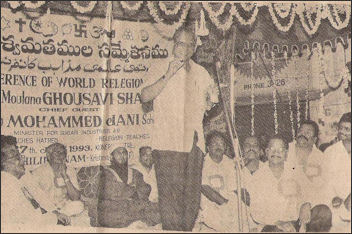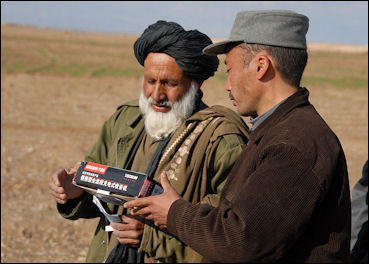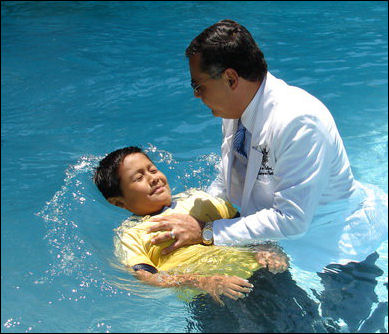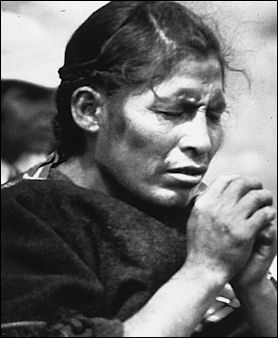RELIGION IN THE DEVELOPING WORLD

Third conference of world religions In many places religion has less to do with ritual than with identity. If a man is born into a Muslim family, for example, he will forever be identified as a Muslim and will most likely marry a Muslim regardless of how religious he is. In many cases it doesn’t matter whether someone is Muslim, Christian, Hindu, Buddhist or Jewish for this to be true.
Even though organized religions such as Christianity, Islam or Buddhism are regarded as the dominate religions, beliefs in magic, mysticism, superstition, spirits, shaman and myths remain strong. Villagers are particularly concerned about demons and spirits of the dead and believe they causes sickness and misfortune.
Villagers generally don't question the existence of God or spirits, they just believe in them. Many take precautions to protect themselves, their families and their homes from these spirits and demons. Many gods and spirits are associated with natural objects or forces: corn gods, earth devil, tree spirits.
Religious Radio in the Developing World

handing out radios in Afghanistan In remote areas and in many parts of the developing world, the faithful rely on radio for sermons, Bible and Koran readings, seminary courses and other forms of religious instruction and communication. Robert Fortner, a specialist in religious broadcasting at the U.S. -based Media Research Institute, told the Washington Post, “In the developed world, many people find that radio is about the only mechanism that is available. They hang on to it in the way people hang on to a life that after a tsunami...These programs connect people to a world that otherwise they have no access to. They indicate to these folks that someone “out there” cares enough about them to prepare programs in their own language and speak to them about their own struggles.” [Source: Kevin Sullivan, Washington Post, October 8, 2007]
Christianity is the dominant but not only the only force in religious radio. Muslim stations broadcasts Koranic recitations, news and music. Hindus, Buddhists and members of other religions have their own broadcasts. In addition to their religious programing, religious broadcasters also often provide world news along with programs that deal with basic health and sanitation issues and family counseling. Many of the Muslim broadcasts are funded by governments in predominately Muslim countries and are oriented towards Muslims.
The spread of religious radio programming has been made possible by the deregulation of the airwaves and the growth of private radio. In Africa, for instance, according to the BBC, there were just two radio stations that were not state-owned in the 1980s; now there are at least 3,000. Since 1991, when the Soviet Union broke up, more than 2,000 private radio stations, many with religious broadcasts have emerged in the 15 former Soviet republics.
Christianity and Missionaries in the Developing World
In 1900, 80 percent of Christians lived in Europe and North America. In 2000, 60 percent lived in Africa, Asia and Latin America, with many in developing countries.

Evangelical baptism Many villagers worship at a church and practice animists religions at home as a way of hedging their bets. They worships both Christian and animist gods, spirits and figures because they don't want to offend either religion and get sick or into trouble. "It won't do me any harm," one villager said. "And you never know."
Western missionaries remain very active in the developing world. Whether the put an emphasis on converting people to their religion or building schools, hospitals, clinics in places where these things often don’t exist often depends on the religious group or the individuals involved. Catholic missionaries are generally regarded as more culturally sensitive than their Protestant counterparts.
Missionaries, See Christianity
Evangelical Christians in the Developing World
Evangelical Protestants are one of the fastest-growing religious groups in the developing world. Their religion and beliefs in many cases were introduced by missionaries but now are largely spread by native followers.
Evangelical Protestants believe in miracles and faith healing and regard the scriptures, especially the New Testament, as more important than the church as an institution. They are known for having great pangs of guilt whenever the commit a sin and undergoing ecstatic experiences when they are filled by the holy spirit. Evangelical sermons are often of a hellfire and brimstone variety, with followers making testimonials, and speaking in tongues. Followers are also often aggressively encouraged to find and win new converts.
Missionaries
Christianity has traditionally been a proselytizing religion spread around the world by missionaries. This is based at least partly on the belief that the message of salvation was offered to everyone and this “Good News” (the meaning of “Gospels”) should be spread by everyone who has experienced it. Missionaries respond to the plea in Matthew: “Therefore go and make disciples of all nations, baptizing them in the name of the Father and the Son and of the Holy Spirit, and teaching them to obey everything I have commanded you.” They also follow the example of St. Paul and St, Francis.
White nurses in Katanga
in the Belgian Congo in 1918 Nearly all branches of Christianity have utilized missionaries in one form or another. These days most mainstream Protestant and Catholic missionary groups stick to operating social programs and helping the poor. Generally the groups that most actively proselytize are evangelicals. Many of the Evangelical get day jobs as engineers, English teachers and nurses and evangelize in their spare time.
Christian missionaries have helped bring education and medical care to remote parts of the world, helped preserve some culture that might have been swallowed up economic forces and assimilation and brought written languages to places that didn’t have one.
For a long time most missionaries were active in Latin America, where the battle for primacy was fought between evangelicals and Catholics, with the more adventurous going to Africa and the Communist world. In the last few decades there has been more of an emphases on reaching “unreached people groups” that include tribes in remote areas and Muslims, Hindus and Buddhists who have never been exposed to Christianity.
Modern technology, wealth, globalization and an endless supply of enthusiastic missionaries willing to travel to the ends of the earth and find those who have not heard the word have helped spread Christianity at an unprecedented rate. There is a wealth of material available on the Internet as well as was “Godcasting” sites for iPods.
Also See History
Christian and Church Radio
Radio is useful for ambitious priests and preachers and other religious people who want to get their message out and find an audience. Even in remote villages in Mozambique or the steppes of Mongolia, radio listeners can tune into sermons by J. Vernon McGee, a Texas preacher, on Jesus and Saint Paul. There are at least a dozen major international Christian radio network that operate in nearly all the world’s countries and broadcast in 360 languages. Most originate in the United States, which has more than 2,000 domestic religious radio stations. But others originate from Britain, Sweden and places like Chile and the Philippines.

Aymara Christian praying in Bolivia U.S.-based Trans World radio, a non-denominational Protestant network, is among the largest religion radio networks. With a budget of $40 million, raised through donations, it is broadcast in more than 200 countries. Trans World was broadcast to 2,800 stations globally in 2007, up from 1,600 in 2001. The Christian Broadcasting Network in Chesapeake Virginia produces foreign-language radio programs which are broadcast in many countries.
Some religion groups distribute $50 hand-crank radios with the help of local pastors. A handful of such radios can go a long way. Sometimes a single radio is all that is necessary to bring radio programming to a village. One Anglican pastor in a village in Mozambique told the Washington Post , “This brings more people to the church. Some people started going to church and gave up, and these programs convinced them to come back. Others have who have never been to church hear this and are convinced to become Christians.”
J. Vernon McGee is one of the world’s most widely-heard preachers. His program “Thru the Bible” is broadcast in 108 languages in 219 countries. Even though McGee died in 1988 his sermons have been kept alive by his followers and listeners who donate everything from pocket change to multi-million -dollar inheritances to keep the broadcasts going. The translations are often done by local preachers in the local languages and dialects. In some places McGee’s broadcasts are the only radio program available in the local language. A listener in Mozambique told Washington Post that McGee’s show is the only radio program he listens to. “It makes me feel good,” he said. “It explains things well. It gives us more than the Bible. It talks about how to live. It adds to what we are taught by our parents and our pastors. I learn about forgiveness. It teaches us to live better.”
Animism and Shamanism
Thai Spirit House Native religions are ones that are practiced on a small scale by particular families, tribes, communities and ethic groups. In the past they were quite common but now have largely been replaced or absorbed by larger, organized religions scuh as Christianity. Those that survive are likely to be found in remote places with relatively little contact with the outside world. Some native religions continues to exist in a form influenced by or incorporated into a more dominant religion. Many local gods and practices live on as saints or rituals within the Christian church.
Native religions vary a great deal from place to place and community to community but many of them have a large number of spiritual beings, such as tree spirits, mountain gods and ancestors, that are involved in wide range of activities. The human leaders are often healers or shaman who have the power to communicate with these spirits, often in another realm.
Native religions often have some kind of belief about the spirit possession of humans, which can cause diseases or some other malady or can be involved in a ritual, rite of passage or communication with another world. There is also some general recognition of evil, evil power and evil spirits and lessons and advice on how to deal with them through magic, faith or good deeds and behavior.
Rituals often hold great importance in native religions. They are often used in healing and to symbolize important natural and life-cycle process such for planting, harvesting, coming of age, marriage or a funeral. Myths, legends and oral traditions also hold a high place and are used to answer the big question of life, explain their beliefs, record history and pass down information from one generation to the next.
See Separate Article ANIMISM AND SHAMANISM factsanddetails.com
Magical Thinking
.jpg)
Muslim Sufi Dervish in Ecstatic
Excitement Piercing his Cheek (1878) Magical thinking — beliefs by individuals that their thoughts and beliefs can produce a desired outcome — are very common, scholars say. There seems to be an evolutionary and physiological explanation: that beliefs in special powers can provide a lift in particularly stressfully situations and help one deal with the wears and tears of everyday life, though the idea should not to be confused with religious beliefs which incorporates large questions about morality, existence, community and history.
In series of experiments performed by Harvard and Princeton psychologists in the summer of 2006 , well-educated adults were asked to watch a blindfolded player play an arcade basketball game and visualize success for the player. Unknown to the subjects was that the game was rigged and the players could see through the blindfold and practiced extensively to make the shot. When asked on a questionnaire if the observers had some impact on the player success many said yes. Subjects responded similarly in an experiment using voodoo dolls on people that feigned headaches and when asked if their actions affected the result of the 2005 Super Bowl.
Princeton’s Emily Pronin, the leader of the study told the New York Times, “The question is why did people create this illusion of magical power? I thinks in part it’s because we’re constantly exposed to our own thoughts — they are most salient to use — and thus we are likely to overestimate their connection to outside events.
Children exhibit a form of magical thinking by about 18 months when they create imaginary worlds while playing. By age three they know the difference between fantasy and reality but still believe in Santa Claus and the Tooth Fairy, By age 8, and sometimes earlier, they have given up on Santa Claus and their beliefs about magic and reality are as clear cut as when they are adults. Some social scientists believe that this is when they start thinking about religion and faith. Jacqueline Woolley, a professor of psychology at the University of Texas, told the New York Times, “The point at which the culture withdraws support for belief in Santa and the Tooth Fairy is about the same time it introduces children to prayer. The mechanism is already there, kids have already spent time believing that wishing makes things come true, and they’re just losing faith in the efficacy of that.”
Image Sources: Wikimedia Commons
Text Sources: New York Times, Washington Post, Los Angeles Times, Times of London, Yomiuri Shimbun, The Guardian, National Geographic, The New Yorker, Time, Newsweek, Reuters, AP, Lonely Planet Guides, Compton’s Encyclopedia and various books and other publications.
Last updated January 2012


